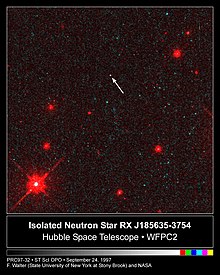RX J1856.5−3754
| Observation data Epoch 1996.7 Equinox J2000.0[1] | |
|---|---|
| Constellation | Corona Australis |
| Right ascension | 18h 56m 35s[1] |
| Declination | −37° 54′ 36″[1] |
| Apparent magnitude (V) | ~25.6[1] |
| Details | |
| Mass | 0.9 M☉ |
| Radius | 19–41 km |
| Age | 1 Myr |
| Other designations | |
RX J185635−3754, 1ES 1853−37.9, 1RXS J185635.1−375433 | |
| Database references | |
| SIMBAD | data |
RX J1856.5−3754 (also called RX J185635−3754, RX J185635−375, and various other designations) is a neutron star in the constellation Corona Australis. At approximately 400 light-years from Earth, it is the closest neutron star discovered to date.
Discovery and location
[edit]
RX J1856.5−3754 is thought to have formed in a supernova explosion of its companion star about one million years ago and is moving across the sky at 108 km/s. It was discovered in 1992, and observations in 1996 confirmed that it is a neutron star, the closest to Earth discovered to date.[2]
It was originally thought to be about 150–200 light-years away,[3] but further observations using the Chandra X-ray Observatory in 2002 indicate that its distance is greater—about 400 light-years.[4][5]
RX J1856 is one of the Magnificent Seven, a group of young neutron stars at distances between 130 and 500 parsecs (420 and 1,630 light-years) of Earth.
Quark star hypothesis
[edit]By combining Chandra X-ray Observatory and Hubble Space Telescope data, astronomers previously estimated that RX J1856 radiates like a solid body with a temperature of 700,000 °C and has a diameter of about 4–8 km. This estimated size was too small to reconcile with the standard models of neutron stars, and it was therefore suggested that it might be a quark star.[4]
However, later refined analysis[5][6] of improved Chandra and Hubble observations revealed that the surface temperature of the star is lower, only 434,000 °C, and, respectively, the diameter is larger, about 14 km (with account of the effects of general relativity, the observed radius appears about 17 km).[5] Thus, RX J1856.5–3754 is now excluded from the list of quark star candidates.[6]
Vacuum birefringence
[edit]
In 2016 a team of astronomers from Italy, Poland, and the U.K. using the Very Large Telescope reported[8][9] observational indications of vacuum birefringence from RX J1856.5−3754. A degree of polarization of about 16% was measured from the visible spectrum being large enough to support evidence but not discovery due to the low accuracy of star model and the uncertain direction of the neutron magnetization axis.[10]
Its inferred magnetic effect of 1013 G should produce a greater effect at X-ray wavelength which could be measured by future planned polarimeters such as NASA's Imaging X-ray Polarimeter Explorer (IXPE), NASA's Polarimetry of Relativistic X-ray Sources (PRAXYS) or ESA's X-ray Imaging Polarimetry Explorer (XIPE).[11]
See also
[edit]- 3C 58, a possible quark star
References
[edit]- RX-J185635-375 at jumk.de
- RX J1856.5-3754 and 3C58: Cosmic X-rays May Reveal New Form of Matter Chandra X-ray Observatory. July 16, 2009.
- Walter, Frederick M.; Lattimer, James M., The Astrophysical Journal, 2002
- ^ a b c d F. M. Walter. "RX J185635-3754 - an Isolated Neutron Star". Department of Physics and Astronomy, State University of New York at Stony Brook. Retrieved June 29, 2007.
- ^ Rees, Martin (2012). Universe. Dorling Kindersley. p. 528. ISBN 978-1-4093-7650-7.
- ^ "The Mystery of the Lonely Neutron Star". European Southern Observatory press release, September 11, 2000. Accessed online at spaceref.com May 20, 2007.
- ^ a b Drake J. J.; et al. (2002). "Is RX J1856.5-3754 a Quark Star?". Astrophys. J. 572 (2): 996–1001. arXiv:astro-ph/0204159. Bibcode:2002ApJ...572..996D. doi:10.1086/340368. S2CID 18481546.
- ^ a b c Ho W. C. G.; et al. (2007). "Magnetic hydrogen atmosphere models and the neutron star RX J1856.5–3754". Monthly Notices of the Royal Astronomical Society. 375 (2): 821–830. arXiv:astro-ph/0612145v1. Bibcode:2007MNRAS.375..821H. doi:10.1111/j.1365-2966.2006.11376.x. S2CID 2046995.
- ^ a b Truemper, J. E.; Burwitz, V.; Haberl, F.; Zavlin, V. E. (June 2004). "The puzzles of RX J1856.5-3754: neutron star or quark star?". Nuclear Physics B: Proceedings Supplements. 132: 560–565. arXiv:astro-ph/0312600. Bibcode:2004NuPhS.132..560T. doi:10.1016/j.nuclphysbps.2004.04.094. S2CID 425112.
- ^ "First Signs of Weird Quantum Property of Empty Space? – VLT observations of neutron star may confirm 80-year-old prediction about the vacuum". www.eso.org. Retrieved 5 December 2016.
- ^ Mignani, R. P.; Testa, V.; González Caniulef, D.; Taverna, R.; Turolla, R.; Zane, S.; Wu, K. (2016-11-02). "Evidence for vacuum birefringence from the first optical-polarimetry measurement of the isolated neutron star RX J1856.5−3754". Monthly Notices of the Royal Astronomical Society. 465 (1). Oxford University Press (OUP): 492–500. arXiv:1610.08323. doi:10.1093/mnras/stw2798. ISSN 0035-8711.
- ^ "Astronomers Report First Observational Evidence for Vacuum Birefringence | Astronomy | Sci-News.com". Breaking Science News | Sci-News.com. Retrieved 2021-10-10.
- ^ Fan, Xing; Kamioka, Shusei; Inada, Toshiaki; Yamazaki, Takayuki; Namba, Toshio; et al. (2017). "The OVAL experiment: a new experiment to measure vacuum magnetic birefringence using high repetition pulsed magnets". The European Physical Journal D. 71 (11). Springer Nature: 308. arXiv:1705.00495. Bibcode:2017EPJD...71..308F. doi:10.1140/epjd/e2017-80290-7. ISSN 1434-6060. S2CID 254140737.
- ^ "Does This Neutron Star Confirm an 80-Year-Old Quantum Prediction?". Sky & Telescope. 2016-12-07. Retrieved 2021-10-10.
External links
[edit]- Is RX J185635-375 a Quark Star?
- NASA Astronomy Picture of the Day: RX J185635-375: Candidate Quark Star (14 April 2002)
- Bare Quark Stars or Naked Neutron Stars? The Case of RX J1856.5-3754
- RX J185635-3754 - an Isolated Neutron Star
- News Release STScI-1997-32: Hubble Sees a Neutron Star Alone in Space

